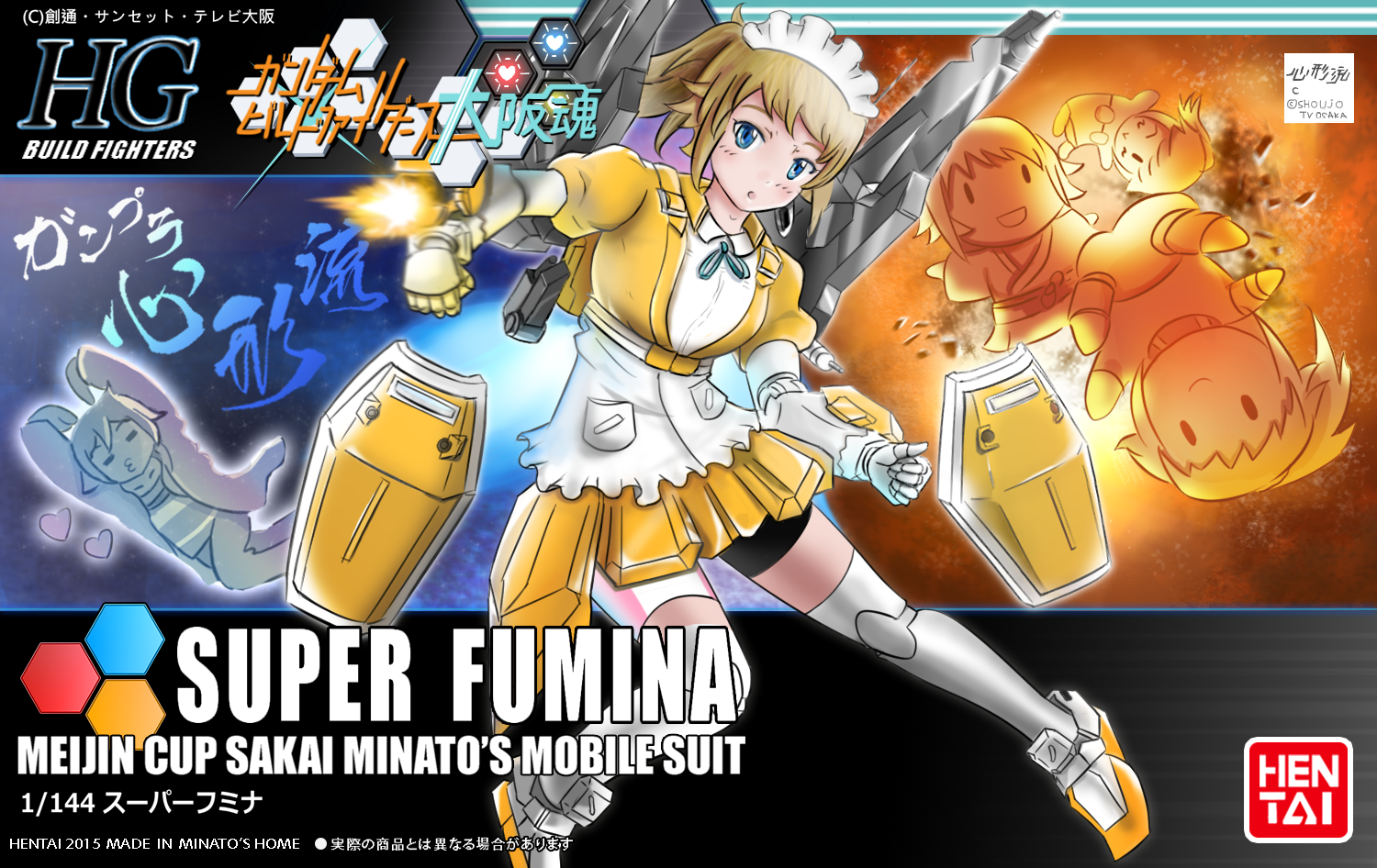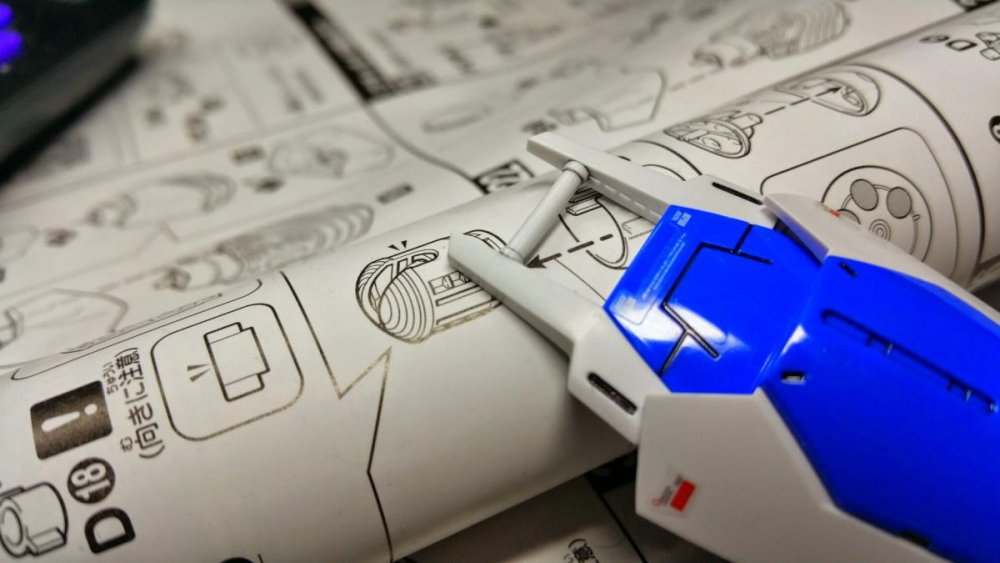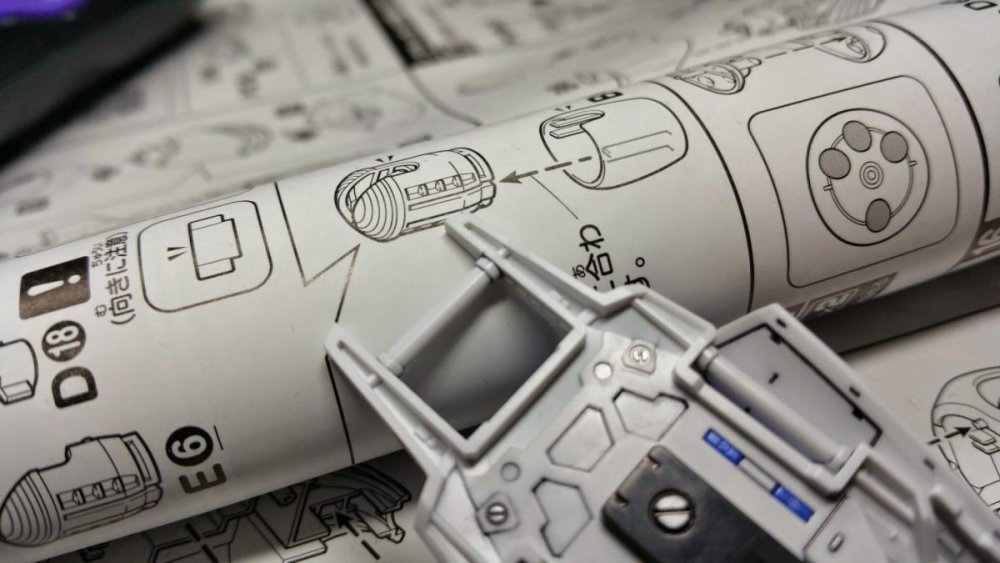-
Posts
675 -
Joined
-
Last visited
Content Type
Profiles
Forums
Events
Gallery
Posts posted by Nekko Basara
-
-
Bringing up the subject of the Plane-Which-Must-Not-Be-Named again, I can receive PBS America despite living in the UK. They've been running a series called "Air Warriors" lately, which looks at various U.S. military aircraft. The actual documentary aspect is a bit underwhelming (the MiG?) but they do have a lot of very neat archive footage (most of the time - I'm pretty sure at one point they were talking about F-15s whilst showing a low-light shot of MIG-29s on-screen) and have covered a few things I didn't know, like the time a few years ago Congress tried to cancel an expensive, underwhelming aircraft after it had already gone into production because it was, well, expensive, underwhelming, difficult to maintain, had had a couple of accidents and didn't work in the wet.
I thought it might be amusing to let you all guess which aircraft we're talking about, but for the impatient modern internet generation answer under the spoiler tag:
My sense is that it's an unfair question, because those things are probably true of all recent US aircraft (maybe all military aircraft generally) - they've all been expensive, difficult to maintain and accident prone early in their careers, didn't work to spec under real conditions, and were underwhelming by at least somebody's expectations. If their cancellation hasn't been attempted by all Congress after the start of production, it's certainly been considered before production, and by at least some Congress-people afterwards.
That's basically just how obtaining something as complex, expensive, and important as a new military aircraft goes, and we shouldn't think it's a sign of inevitable failure. Which is, I think, exactly your point.

-
Being shallow, cheerful, diverting, and fun doesn't make music "bad" - that just serves as a decent generalized definition of Pop. Whether you like that or not is purely a matter of taste and mood.
Gubaba can correct me if I'm wrong, but I also think that being a less-than-amazing singer is part of the idol image, at least early in their career. Idols are supposed to have an inexperienced, girl-next-door appeal rather than being mind-blowing natural talents. Watching and "supporting" them as they mature into capable artists is a big part of idol fandom.
-
Argh, Fan Art!

-
You know an AGP is going to happen. it makes too much sense and will probebly sell the better than any other figure in the line.
I want to believe, I really do. But AGP releases seem to be so scattershot, and what focus they have is anchored on KanColle right now. And on top of that, even if Fumina gets made, Bandai figure quality quality can be so hit-or-miss.
Ok, now I'm just depressing myself!
-
I really want to see Super Fumina in the AGP line. Or a kit. Or even a plushy. Something!
-
Why would Macross battle Gundam? Most of the money from both series goes into the same pockets, so it benefits them to capture different consumers.Sounds like a brilliant strategy to battle gundam
-
The discussion in the main forum about the PLZ-230 Skorpion got me thinking about another lightweight, low-cost attack aircraft project, the Scaled Composites ARES. From that, Wikipedia led me to another arachnid I'd never even heard of:
the Textron AirLand Scorpion. Anybody know much about this little beastie?

-
Wow, I had no idea. From the picture, I thought I was looking at a high-end kit plane for rich Top Gun dreamers.
Damned thing looks like it would make the He162 seem long-legged and well-equipped. Hard to believe they were serious.
-
What's that Engadget is watching during their Samsung S6 Edge review? (Check the screenshot about 1/3 of the way down.)
-
hey guys, does this look real?
i tried following that video beginners gunpla. i attempted using the silver on the side hip bars to make it look like paint chipping of metal using a tooth pick.
I think that looks like realistic paint chipping, yes. You are being brave, and I think that's awesome. Don't worry about subtlety - I say go overboard with weathering and get more practice. You can dial it down when you have more comfort with the techniques.
In terms of whether that looks "real" - get ready for a long-ish post.
One of the reasons that I don't personally get into weathering gunpla very much (although I appreciate the work of those who do) is that I don't have a good sense of what is "real" weathering in a giant military robot context.
Weathering isn't just a matter of technique - it's about asking questions and making observations.
I like to ask, what is this surface made of? How does it weather? If it's a paint, how easily does it come off and where does that tend to happen? In what way does it come off (does it flake off with sun or time, does it scrape off in a direction, etc.)? What's underneath, and how will that look when it's revealed (is there a tougher primer coat that becomes visible, or is it bare metal; will the process that removed the paint damage the metal or leave it smooth)? If the surface is metal, how does it oxidize (change color) and how recent is the damage (should it be bright and fresh or dull and oxidized)? To give some examples, WWII aircraft tend to get most of their paint wear from personnel, so there will be a lot of paint wear on the wing surfaces where the pilots board and some where maintenance personnel work (like around the engine and gun bays in the wings). Anyplace there is a panel that gets removed regularly, expect its edges and especially any bolts to show wear. There can also be wear on the leading edges of the wings and the prop from dirt/sand/rocks in the air during landing or takeoff, depending on the operating environment. These planes are mostly made of aluminum, so surfaces where paint is removed don't oxidize much and stay a bright or dull silver/gray. There are also special cases - for example, Japanese aircraft, particularly late in the war, had pretty bad paint and were exposed to lots of strong sunlight, so very often the paint would start flaking off with little or no provocation, especially around edges. WWII armor is very different - it tends to have a very heavy and resilient paint, with a primer under it that will sometimes be exposed by (or, at least, visible at the edges of) damage to the surface. Damage to the paint comes from personnel, but also largely from scraping through vegetation, running over and into dirt and stones, and of course sometimes from enemy fire. The underlying material is steel, so it oxidizes quickly and darkly, and there can even be staining from rust in some situations.
For observations, I like to look at period photos, of course (although these are rarely color, so that complicates things). But I'll also look at modern photos, or visit museums and displays, especially outdoors. On top of that, I just try to notice any machinery or similar objects I can in day-to-day life. One of the best resources for armor weathering, for example, is to just pay attention to construction sites and see all the ways that equipment gets scraped up and dirty. I've taken wrong turns on the road because I wanted to keep looking at a particularly interesting looking old semi- or dump-truck.
The trouble for me with mobile suits is that I don't have a way to answer so many of my questions or make relevant observations. I don't know how the paint on a Gundam acts (if they even are painted), or how Luna Titanium oxidizes. I have trouble imagining what areas the maintenance personnel move around on, or what they open frequently. Would all of a Gundam's armor be covered in scrapes, or just up to the height of bushes or trees? Can the limbs impact the body and each other, the way human limbs can, or are there limiters built into the system to prevent contact? Of course, at some level it's fun to think about these things and simply make up answers. But it feels too easy to just slip into covering a mobile suit with scrapes and paint chipping without regard for if or how it could happen. Part of the fun for me in both producing and appreciating weathering is the thought behind the process.
At the end of the day, though, the goal of weathering and other detailing techniques isn't to replicate reality, but to give the viewer a sense of reality - which will, by nature - be subjective. If you think about panel lining and dry brushing, as examples, there are very few real situations that will cause dark material to build up in all the cracks on an object, or cause the paint on all of its edges to lighten. Those techniques aren't replicating reality in a literal sense. What they are doing is giving a sense of shadow and reflection that bring out details lost to scale. They make a model in a case more closely resemble to our eyes and (more importantly) our mind what a full-sized object in bright light would look like. By the same reasoning, while it might not make strict sense that a 6-story robot would be covered from head-to-toe in scrapes and paint chips, if that looks more "real" to your sense as an artist, then go for it.
-
New mobo is here. While it does have many fan connectors, they are kinda in weird locations IMHO, mostly concentrated down/forward. (I usually check that, must have forgot for this specific model variant) From googling, it seems that running a case fan off of the "CPU_OPT" header should be fine, and it was recommended that the rear fan use that one, so that it's "in sync" with the main CPU fan. (as otherwise I'm going to be running some long fan cables all around the case to make it work)
Anyone have any comments/experience with running case fans off a CPU_OPT spot? (seems the primary use for a CPU_OPT connector is to provide a second one for water-cooling setups etc)
David, which mobo did you pick, out of curiosity? I glanced back through the thread, but I must have missed it.
-
That's the main reason I bought a more expensive mobo than originally planned---needed a decent number of controllable fan ports.
Oh, good thinking. Controlling fans within the BIOS is even better, although you typically either need more expensive PWM fans (4-pin), or you are limited to a few settings for voltage-regulated (3-pin) fans.
-
I think bottom-mounted fans are great if a case (like yours) has a spot for them. Just make sure to give it a few inches of clearance off of a hard surface, which can mean augmenting the short feet of some cases; if you are placing it on carpet, put a board or something underneath it as well.
You can get a nice airflow setup with intakes at the front and bottom (many PSUs also function as an intake) and exhausts at the rear and top. That sends air over your video card as well as your CPU, and follows the natural tendency of warm air to rise.
I completely agree with frothymug that placing intake and exhaust next to each other isn't a great idea. Another way you can get the intake/exhaust ratio you want is to use fan controllers to slow down the fans to varying degrees. This has the added benefit of reducing noise (and a lot of controllers look sexy as well). Some fan controllers also include temperature sensors, and can be programmed to dynamically adjust fan speeds with heat load, although personally I've never felt the need to set that up on mine.
-
Well, they haven't completely abandoned the term... it crops up a lot in Variable Fighter Master File, for instance.
They just gave the acronym a slightly different meaning. It became "Fuel, Arms, and Sensors Tactical" in the VF-25 book. The most recent volume (the VF-22 book) still uses it.
Believe it or not, that brings me a lot of peace.

EDIT: Although "Fuel, Arms, Sensors, and/or Thrusters" would be even better!
-
Also consider how much intake you have versus exhaust. Too much of one kind would be a waste.
I'll disagree with this in the context of positive pressure cooling setups.
My home is dusty - neither my wife or I would win awards for cleanliness, and we have several kinds of pets producing dander, fur, feathers, etc. Keeping computer cases from becoming dust traps has been a struggle. The last set I built, I set all of the cases up for "positive pressure," with about 50% more fans blowing in than out. All of the intake fans got dust covers, and I closed off any other large openings in the cases (except the ones with exhaust fans). The idea is that the air inside the case is at slightly higher pressure than the air outside, so that anyplace there is a leak (and a computer case leaks like a sieve), the air is coming out rather than sucking dusty air in. It's the same concept used in special hospital rooms, "clean rooms" in manufacturing, and NBC-proofed vehicles (albeit on a much less rigorous level here).
For me, this has been a complete success. The fan covers get filled with lint pretty quickly, but they are easy to clean off. When I have opened the cases every few months to clean them out, I've never found more than a faint coating of the very finest dust. I've been running that setup for about 18 months, and I'm ready to declare victory. I admit, it's almost certainly a less efficient use of airflow than maximizing throughput (because airflow is lost both to the pressurization and to the filters), but nothing kills airflow worse than a dust-clogged case. So, unless you have a pretty sterile computer environment or are fanatical about frequent cleaning, I'd suggest checking this approach out.
EDIT: I was just responding to frothymug and didn't realize that David asked specifically about positive vs negative pressure earlier. I hope this didn't come off as too basic or preachy.
-
The FAST Pack idea has changed somewhat. Look at the Silent Eagle, the conformal bays now only contain armaments, not fuel. So In this case it's life imitating art, rather than the other way around.
Yeah, but the point is that those conformal bays are no longer referred to as "FAST Packs." The acronym stopped being used when it no longer applied... except in Macross, where it was always used despite never applying.
Also, it's probably worth noting that the Silent Eagle is a more recent development than any Macross series.
EDIT: Oh, I see now that's what you were commenting on with the "life imitating art" bit.
-
Typing is another one of his skills.
-
Just to derail things from the get-go (sorry!), I don't think Basara or Mylene should be considered idols. Curious how folks feel about that.
In-universe, I'd lean towards Sharon Apple for how unique her sound is, and how ahead-of-its time the virtual idol concept was (not saying she was first, but she's one of the best-realized early examples).
In the real world, Mai Yamane is my favorite voice from Macross, although her connection is very tenuous. Chie Kajiura is my number two, obviously with a much stronger association. Of course, one could argue that neither of them is an idol, either.
-
wiki says:
McDonnell Douglas modified the second TF-15A prototype, serial number 71-0291, as a demonstrator. The aircraft, known as the Advanced Fighter Capability Demonstrator, first flew on 8 July 1980.[9] It was previously used to trial conformal fuel tanks (CFT), initially designed for the F-15 under the designation "FAST Pack", with FAST standing for "Fuel and Sensor, Tactical.[9] It was subsequently fitted with a Pave Tack laser designator targeting pod to allow the independent delivery of guided bombs.[11] The demonstrator was displayed at the 1980 Farnborough Airshow.[12]
I'm guessing I'm not the only person on these boards who gets slightly annoyed by the use of the "FAST Pack" term in Macross, when the main purpose of the packs seems to be adding thrusters and munitions, with fuel present only for the thrusters and no sensors to speak of.
-
Krylon makes an acrylic clearcoat that I've been happily with so far. I gave some more detail a couple of pages back.
Also, the very pricey but very popular Mr. Hobby topcoat line is acrylic.
I'd never want to use an enamel (alcohol-based) clearcoat on anything but bare plastic, because there's a chance it could dissolve underlying paints, marker, weathering, etc. I know from recent experience that Testors clearcoat will cause Gundam panel lining markers to run like crazy.
-
It makes their ass and calves look tight, obviously.Never understood the need of mobile suits with high heel feet. Must be a spacenoid thing cause it's very ineffective on uneven terrain like.......an asteroid
-
Hey, this is really lame because I'm trying to get a picture of something tiny that you basically can't see, but here is a repaired part:
When I got my RG GP-01, one side of the handle at the top of the shield was broken off and loose in the bag. I was able to glue it back on and sand it flush enough that the break can't be seen unless you know right where it was. From the front, the break is right about where that arrow is pointing. It's a bit more visible from the back. Bad pictures aside, my point is that modeling cement can work some wonders!
-
Damn my clumsy fingers. I broke an armor piece on my MG Sazabi.
 Does anyone know if there is a way to glue polystyrene together? The manual states PS on the runner so I assume that is the material they used.
Does anyone know if there is a way to glue polystyrene together? The manual states PS on the runner so I assume that is the material they used.Model "cement" actually melts polystyrene and effectively welds pieces together, so it's ideal for making a strong and seamless fix like that. The thinner the better in that case, so that you don't have excess adhesive around the bond (some people use straight-up methyl ethyl ketone). Apply it sparingly to both surfaces, give it a few seconds to get tacky, then press them together. After a few hours, clean up the seam with sandpaper and you might be able to make it nearly invisible.
-
please pardon the double post:
nekko, i found a set of the rg decals for the iwsp if you need:
http://www.ebay.com/itm/Gundam-decals-RG-STRIKE-ROUGE-HG-IWSP-60911-/181139142741
I forgot to say thank you for the link, David. I'm not sure how I feel about using a whole mess of waterslides just for the IWSP, but it's cool to have the option.
Also, Hikuro, very ballsy with that battle damage. I think it looks great!




Gundam Build Fighters/Build Fighters Try
in Anime or Science Fiction
Posted
That's basically the gag that anything can work set to the Titan theme, as parodied here.